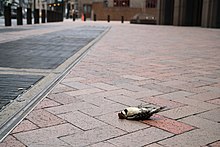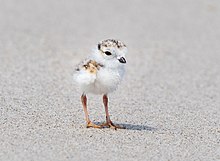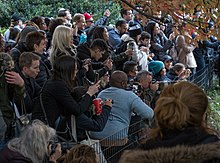Birding in New York City
[4] New York City was the epicenter of the pandemic in the United States in March and April 2020, and with most businesses and schools closed, people looked for activities they could do while outdoors and socially distanced.
[17][7] During migration, when a large number of birds pass over the city, they have limited options for places to land, rest, forage, or breed.
[23] Parts of the former industrial waterfront areas of Brooklyn have been converted into public space, included some which attract a range of waterfowl and other aquatic birds.
Bush Terminal Pier Park, which opened in 2014, is a common birding spot for the ducks, gulls, raptors, and other species it attracts.
At the time it was not accessible to the general public, and became known for grassland birds like eastern meadowlarks, grasshopper sparrows, and upland sandpipers in the summer, and raptors like northern harriers and short-eared owls in the winter.
[29] It is also the site of a variety of public projects, such as relief operations during Hurricane Sandy and construction of a pipeline, which have led to some additional development of former wildlife habitats.
[32][33] There are populations in Gravesend, Marine Park, and in Midwood by the Brooklyn College athletic field, but the largest and best known colony is in the landmarked Gothic arch at the entrance to Green-Wood Cemetery, where they have been permitted to reside indefinitely.
The refuge was established by the NYC Parks Department in 1953, and included the creation of two ponds on either side of Cross Bay Boulevard.
[43] It is part of the Jamaica Bay Unit of the Gateway National Recreation Area, alongside other Queens birding destinations like Breezy Point Tip, Jacob Riis Park, and Fort Tilden.
Great Kills Park, Miller Field, and Fort Wadsworth are part of the Gateway National Recreation Area.
[50] The southern tip of Conference House Park, which is also the southernmost point in New York State, has a view of the ocean that provides an opportunity to see seabirds.
Eventually, ten species of the family were identified nesting on islands of New York and New Jersey harbor, sparking a conservation project subsequent legislation to protect the colonies.
[57][58] One of the people who pushed for the sparrows' import was pharmacist and amateur ornithologist Eugene Schieffelin, who went on to lead the American Acclimatization Society, a group focused on introducing European species to North America.
[10] Several birds once known to breed in the city, like short-eared owls and upland sandpipers, have stopped due to the encroachment of human activities and destruction of their desired habitats.
The environmental movement, starting in the 1960s, helped to improve the quality of the city's air and water and raise awareness of the effects of DDT.
The influential book by Rachel Carson, Silent Spring, credited with swaying public opinion about DDT, was in part based on research by New York City birder Joseph Hickey.
A barred owl known as Barry was killed in the park in 2021 when she collided with a maintenance vehicle, perhaps affected by the quantity of rat poison inside her.
Ways to avoid bird–window collisions include signals, screens, films, fritting, and various other window treatments, but they can be costly to retrofit.
It involves dozens of high-power lights shining upward into the sky, and since its first run in 2002, it was found to trap large numbers of migrating birds.
[72] In 2019, New York City Council passed a law which requires all new construction or building alterations that replace exterior glazing to use bird friendly materials.
[79] The Cornell Lab of Ornithology maintains rare bird alerts for each of the New York City counties which are delivered by email on a daily or hourly basis, but restricts some information about sensitive species and the audience is not as broad as social media platforms provide.
[79][80] It highlighted a set of Twitter accounts run by birder David Barrett, Manhattan Bird Alert and its counterparts for other boroughs, which have tens of thousands of followers.
[84] The resulting attention led to state legislation classifying as a hate crime the false reporting of criminal incidents by members of protected groups.
It primarily serves people and places in the New York City area, and has a long-standing relationship with the American Museum of Natural History.
[8] The National Audubon Society, a non-profit environmental organization dedicated to conservation of birds and their habitats, is headquartered in New York City.
It coordinated protests of the removal of a nest belonging to a red-tailed hawk named Pale Male, which became a minor local celebrity.
Roger Tory Peterson, a naturalist and illustrator from western New York, was also admitted as a member due to his skills as a birder.
It opened a dedicated facility on Columbus Avenue on Manhattan's Upper West Side in 2012, treating up to 400 birds at a time and 7,000 yearly patients as of 2020.
[45] The New York City Plover Project was founded in 2021 to watch over the birds, educate beach-goers, and try to enforce existing regulations.
[110] This can lead to conflict in rare cases, when beach-goers resent or ignore rules regarding fenced off areas, off-leash dogs, flying kites, or setting off fireworks.


















